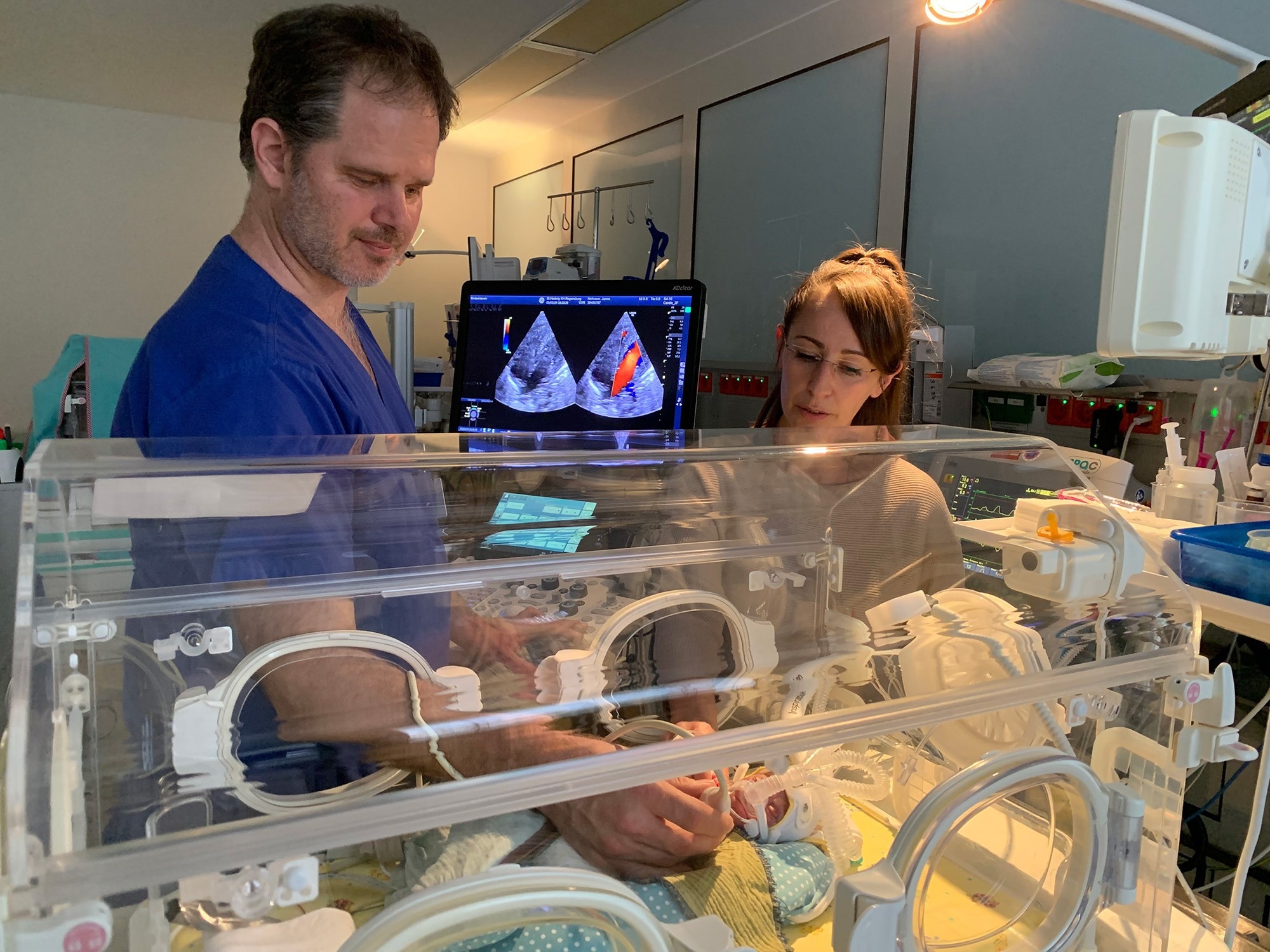Researchers from ETH Zurich and KUNO Klinik St. Hedwig in Regensburg have created an algorithm that offers a reliable and automatic method for identifying a specific kind of heart defect in newborn babies.

Pediatric cardiologist Dr. Holger Michel during a cardiac ultrasound examination of a 7-week-old Jarmo in the presence of his mother. Image Credit: Sven Wellmann/KUNO Klinik St. Hedwig in Regensburg.
Numerous infants announce their arrival in the delivery room through a piercing cry.Upon taking their initial breath, newborns experience automatic lung expansion, widening of lung blood vessels, and an overall recalibration of their circulatory system to adapt to life outside the womb. However, this process does not always go to plan.
Some infants – especially those who are severely ill or born prematurely – may experience pulmonary hypertension, a serious condition characterized by narrowed or closing arteries leading to the lungs shortly after birth. This constricts the flow of blood to the lungs, reducing the amount of oxygen in the blood.
Prompt Diagnosis and Treatment Improve Prognosis
Prompt identification and swift treatment of severe pulmonary hypertension are crucial for the well-being of newborns. Early initiation of treatment significantly improves the prognosis for the infant. Yet making the correct diagnosis can be quite difficult. Only seasoned pediatric cardiologists have the skillset to diagnose pulmonary hypertension based on a comprehensive ultrasound examination of the heart.
Detecting pulmonary hypertension is time-consuming and requires a cardiologist with highly specific expertise and many years of experience. Only the largest pediatric clinics tend to have those skills on hand.
Sven Wellmann, Professor and Medical Director, Department of Neonatology, KUNO Klinik St. Hedwig
KUNO Klinik St. Hedwig is a part of the Hospital of the Order of St. John, Regensburg, Germany
Scientists from the Medical Data Science Group at ETH Zurich, under the direction of Julia Vogt, recently collaborated with neonatologists at KUNO Klinik St. Hedwig to create a computer model that offers reliable support in identifying the illness in newborns. The International Journal of Computer Vision has published their findings.
Making AI Reliable and Explainable
The ETH researchers commenced their algorithmic training process using an extensive dataset comprised of hundreds of video recordings derived from ultrasound examinations conducted on the hearts of 192 newborns.
This dataset encompasses dynamic imagery capturing the heart's motion from various angles, alongside diagnoses provided by seasoned paediatric cardiologists, indicating the presence or absence of pulmonary hypertension, and an assessment of disease severity categorized as either "mild" or "moderate to severe."
To assess the algorithm's efficacy in image interpretation, the researchers incorporated a secondary dataset comprising ultrasound images from 78 newborn infants previously unseen by the model. The model demonstrated an accuracy of approximately 80 to 90 percent when it came to correctly suggesting diagnoses and achieved a precision rate of around 65 to 85 percent in determining the appropriate level of disease severity.
The key to using machine-learning model in a medical context is not just the prediction accuracy, but also whether humans are able to understand the criteria the model uses to make decisions.
Julia Vogt, Scientist, Medical Data Science Group, ETH Zurich
This is made possible by Vogt’s model, which highlights the areas of the ultrasound image that serve as the basis for classification.
This enables doctors to pinpoint precisely which areas or traits of the heart and its blood vessels the model deemed questionable. Upon reviewing the datasets, the pediatric cardiologists found that, despite not having been specifically programmed to do so, they discovered that the model looks at the same characteristics as they do.
A Human Makes the Diagnosis
It may also be possible to apply this machine-learning model to diagnose disorders of other organs and diseases, such as valvular heart disease or defects of the heart septum.
Additionally, in regions lacking specialist availability, standardized ultrasound images could be captured by healthcare professionals. Subsequently, the model could offer a preliminary risk assessment and indicate whether consultation with a specialist is necessary.
Medical facilities that do have access to highly qualified specialists could use the model to ease their workload and to help reach a better and more objective diagnosis.
AI has the potential to make significant improvements to healthcare. The crucial issue for us is that the final decision should always be made by a human, by a doctor. AI should simply be providing support to ensure that the maximum number of people can receive the best possible medical care.
Julia Vogt, Scientist, Medical Data Science Group, ETH Zurich
Journal Reference:
Ragnarsdottir, H., et al. (2024) Deep Learning Based Prediction of Pulmonary Hypertension in Newborns Using Echocardiograms. International Journal of Computer Vision. doi.org/10.1007/s11263-024-01996-x